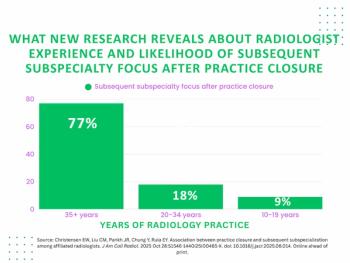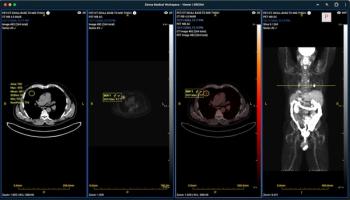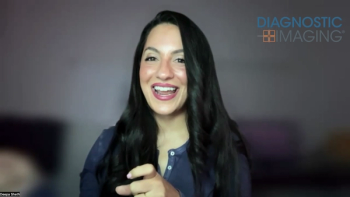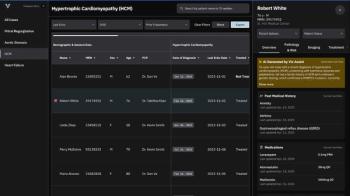
Telemammography Taking Hold
The number of mammography scans is rising, but the number of radiologists willing to read the studies is falling. Enter telemammography.
Over the past decade,
As of January 1, according to the American College of Radiology, there were 8,125 accredited mammography facilities nationwide, down from 9,400 in 2000. Many in the industry have turned to telemammography as the best way ensure patients still have access to screening and diagnostic scans. The number of companies offering telemammography is still small, but the group is growing.
“The potential for telemammography is huge - women over 40 will need to have their mammograms,” said Timothy Myers, MD, a reading radiologist with teleradiology company vRad. “The issue, however, is there just aren’t a lot of players. Teleradiology is just now coming to an age where it’s easy to transfer images.”
As part of its teleradiology services, vRad also offers telemammography.
The premise behind telemammography is the same as general
Although there is some disagreement between industry experts and practitioners about whether telemammography is equally as useful for screening and diagnostic mammograms, overall the strategy has received a warm - if slow - reception.
Remote Reading Benefits
Referring facilities, both large and small, benefit in many ways from telemammography, said Judy Meyers, manager of U.S. diagnostic teleradiology for International Teleradiology Corporation (ITC). Meyers coordinates partnerships between clinical facilities and telemammographers, and she said the telemammographer’s experience level is paramount.
“The biggest thing I hear is the referring providers are so happy with the expertise and competence of the telemammographers,” she said. “They’re confident they can rely on the highly skilled radiologists who focus only on reading mammograms.”
In fact, telemammography effectively ensures clinical settings anywhere have access to subspecialist, fellowship-trained breast image experts, said Martha Garrison, MD, president and chief executive officer for Atlanta-based TeleMammography Specialists, a company that offers both screening and diagnostic mammography reads. In her 16-year career, she has read more than 250,000 mammograms and said a contract with a breast imaging subspecialist gives all facilities access to the same level of service.
“Through telemammography, I - and other breast specialists - am able to bring quality care anywhere,” said Garrison who has clients in 27 states. “We can help patients anywhere in the United States. Both patients and providers are starting to understand that it doesn’t matter if the doctor reading the mammogram is in the same state as the patient.”
She’s seen that comfort level in how her business has grown. Since opening TeleMammography Specialists in August 2010, her business as tripled.
In many cases, especially with larger facilities, telemammography can turn practices into a hub for interpreting screening mammographies and a referral center for diagnostic scans, said Ellen Shaw de Paredes, MD, founder and director of the Virginia-based Ellen Shaw de Paredes Institute for Women's Imaging.
Farming out mammogram reads can also lighten the workload for staff radiologists. In 2004, the Institute of Medicine reported fewer radiologists were choosing to read mammograms because doing so - and doing it incorrectly - carries a higher likelihood of being sued. The lower numbers means facility-based breast image specialists are often overwhelmed with scans and cannot provide a speedy turnaround, said Arthur B. Diamond, founder of telemammography firm Breasthawk™ in a May 2010 Breast Center Bulletin op-ed.
“With the additional help of a telemammographer, turnaround time will be quicker and the interpretation and scheduling backlogs can be reduced or eliminated, providing enormous benefits to patients, breast centers, hospitals and radiology practices,” Diamond wrote. “Telemammography can help the client expand or increase the screening practice without overburdening the on-site breast imager(s).”
But it’s ultimately the patient who benefits the most, vRad’s Myers said. Specialists have a significantly lower callback rate than do general radiologists, often as low as 1 percent to 2 percent. Not only does this level of accuracy save patients time and unnecessary costs, but it can also spare them emotional stress.
In addition to patient care, research efforts, such as BRCA1 studies, can also benefit from telemammography. As a digital method, it can transfer any records to the National Cancer Registry so all researchers can access the data.
Telemammography’s Challenges
While telemammography brings benefits, challenges to its implementation and acceptance remain. To date, the lack of proper technology among referring practices has been the biggest roadblock, said ITC’s Meyers.
“Practices need to know the type of digital equipment they must have to take advantage of telemammography,” she said. “They have to be able to send large images via the Internet, and they must follow all HIPAA guidelines, making sure all the images are encrypted and password protected.” Telemammography work stations must be more sensitive than teleradiology equipment. High resolution is necessary to identify minute lesions, so images can’t be compressed. Consequently, mammogram images are larger than diagnostic studies (35 to 55 megabytes per film instead of 20 to 40). In some cases, providers must also invest money in computer-assisted diagnostic software.
Relying on an off-site mammographer for a diagnostic study can also present a problem, Meyers said, because it requires more direct communication between the telemammographer, the referring physician, and the patient. However, social media tools, such as Skype, allow for face-to-face discussions about any findings, either between providers or directly between the telemammographer and the patient. Video conferencing can give patients a visual, more tangible connection with the provider during a potentially difficult conversation.
Those conversations can also help conquer another barrier, Garrison said. Much of feeling confident about a diagnosis is borne out of a close relationship between technologist and specialist.
“The ultrasound technologists must know what I’m likely to look for, and I need to know how he or she works,” she said. “These days, I’m talking to my technologists at least once a week.”
Overall, telemammography has advanced far over the past five years, Myers said. Improved technology, clear guidance about providing distance services, and a growing comfort with telemedicine has opened the door for this service method to take hold. But there is still room to progress, he said.
“We’re on the cusp of being able to expand meaningful use and expand the ease with which we transfer images,” Myers said. “Once we conquer the concerns about using it for diagnostic mammograms, the use of telemammography is very inspiring.”
Newsletter
Stay at the forefront of radiology with the Diagnostic Imaging newsletter, delivering the latest news, clinical insights, and imaging advancements for today’s radiologists.






























